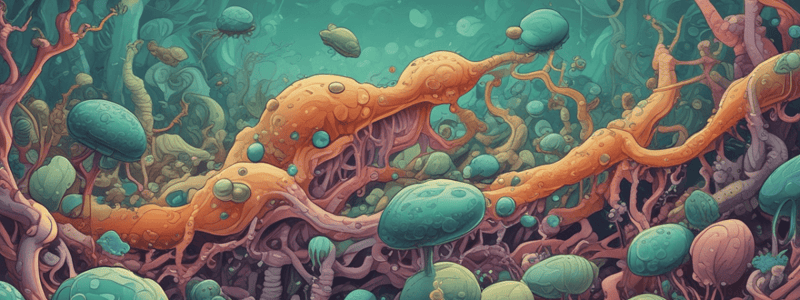Podcast
Questions and Answers
What are the three characteristic shapes of bacteria?
What are the three characteristic shapes of bacteria?
Bacillus, Cyanobacteria, Dinoflagellates
Which of the following are characteristics of protists? (Select all that apply)
Which of the following are characteristics of protists? (Select all that apply)
- Multicellular (correct)
- Photosynthetic (correct)
- Eukaryotic (correct)
- Heterotrophic (correct)
- Unicellular (correct)
Lichens are mutualistic composite organisms with _____?
Lichens are mutualistic composite organisms with _____?
fungi
Amoeba are autotrophic organisms.
Amoeba are autotrophic organisms.
Match the plant organ with its primary functions:
Match the plant organ with its primary functions:
What are the three characteristic shapes of bacteria?
What are the three characteristic shapes of bacteria?
Which of the following are characteristics of protists? (Select all that apply)
Which of the following are characteristics of protists? (Select all that apply)
What are the characteristics of fungi?
What are the characteristics of fungi?
Lichen are mutualistic composite organisms with ___________?
Lichen are mutualistic composite organisms with ___________?
What is the reproductive characteristic of pine?
What is the reproductive characteristic of pine?
What are the primary functions of plant organs?
What are the primary functions of plant organs?
Flashcards are hidden until you start studying
Study Notes
Kingdom Bacteria (Domain Bacteria)
- Prokaryotic
- Three characteristic shapes of bacteria: bacillus, pilus, and flagellum
- Bacillus is a Gram-positive bacteria
- Cyanobacteria examples: Oscillatoria, Anabaena, and Gloeocapsa
- Structure: pilus, flagellum, cell wall, plasma membrane, capsule, nucleoid, ribosome, and plasmid
Kingdom Protista (Domain Eukarya)
- Characteristics: eukaryotic, unicellular or multicellular, photosynthetic or heterotrophic
- Examples:
- Spirogyra: filamentous green algae
- Diatoms: unicellular algae
- Dinoflagellates: unicellular, two flagella
- Euglena: both autotrophic and heterotrophic, eyespot and flagellum
- Amoeba: heterotrophic, movement by pseudopodia
Kingdom Fungi
- Characteristics: eukaryotic, heterotrophic, can be unicellular or multicellular, can reproduce sexually and asexually
- Structure: hyphae, mycelium (composed of hyphae)
- Examples:
- Rhizopus: asexual and sexual reproduction, bread molds
- Penicillium
- Yeast: unicellular, budding
- Coprinus: common mushroom, gill part
- Lichen: mutualistic composite organisms with fungi and algae
Kingdom Plantae
- Nonvascular plants (Lab 6): characteristics of mosses
- Alternation of life cycle: dominant gametophyte vs. sporophyte
- Female and male gametophyte (archegonia and antheridia)
- Seedless vascular plants (Lab 7): characteristics of ferns
- Alternation of life cycle: sporophylls (spore-forming leaves), sori (cluster of aggregated sporangia), independent sporophyte
- Female and male gametophyte (archegonia and antheridia)
- Gymnosperms (Lab 8): characteristics of pine
- Exposed seeds on cones, heterosporous (microspores and megaspores)
- Needle-like evergreen leaves, evolutionary adaptation
- Seed (ovulate) cone and pollen (staminate) cone
- Angiosperms (Lab 9): characteristics
- Flower anatomy: petal, sepal, carpel, stamen
- Roles of flowers and fruits in angiosperm reproduction
- Double fertilization process: two sperms fertilize egg and polar nuclei, and these become embryo and endosperm
Plant Anatomy
- Primary functions of plant organs: roots (absorb water and minerals), leaves (stomata, photosynthesis), stems (support, transport)
- Differences between monocot and dicot plants:
- Leaf venation, number of petals, growth pattern, cotyledon, arrangement of vascular tissues in stem and root
- Differences between primary and secondary growth of plants
- Monocot/dicot root and stem cross-sections
- Leaf cross-section (dicot)
Kingdom Bacteria (Domain Bacteria)
- Prokaryotic
- Three characteristic shapes of bacteria: bacillus, pilus, and flagellum
- Bacillus is a Gram-positive bacteria
- Cyanobacteria examples: Oscillatoria, Anabaena, and Gloeocapsa
- Structure: pilus, flagellum, cell wall, plasma membrane, capsule, nucleoid, ribosome, and plasmid
Kingdom Protista (Domain Eukarya)
- Characteristics: eukaryotic, unicellular or multicellular, photosynthetic or heterotrophic
- Examples:
- Spirogyra: filamentous green algae
- Diatoms: unicellular algae
- Dinoflagellates: unicellular, two flagella
- Euglena: both autotrophic and heterotrophic, eyespot and flagellum
- Amoeba: heterotrophic, movement by pseudopodia
Kingdom Fungi
- Characteristics: eukaryotic, heterotrophic, can be unicellular or multicellular, can reproduce sexually and asexually
- Structure: hyphae, mycelium (composed of hyphae)
- Examples:
- Rhizopus: asexual and sexual reproduction, bread molds
- Penicillium
- Yeast: unicellular, budding
- Coprinus: common mushroom, gill part
- Lichen: mutualistic composite organisms with fungi and algae
Kingdom Plantae
- Nonvascular plants (Lab 6): characteristics of mosses
- Alternation of life cycle: dominant gametophyte vs. sporophyte
- Female and male gametophyte (archegonia and antheridia)
- Seedless vascular plants (Lab 7): characteristics of ferns
- Alternation of life cycle: sporophylls (spore-forming leaves), sori (cluster of aggregated sporangia), independent sporophyte
- Female and male gametophyte (archegonia and antheridia)
- Gymnosperms (Lab 8): characteristics of pine
- Exposed seeds on cones, heterosporous (microspores and megaspores)
- Needle-like evergreen leaves, evolutionary adaptation
- Seed (ovulate) cone and pollen (staminate) cone
- Angiosperms (Lab 9): characteristics
- Flower anatomy: petal, sepal, carpel, stamen
- Roles of flowers and fruits in angiosperm reproduction
- Double fertilization process: two sperms fertilize egg and polar nuclei, and these become embryo and endosperm
Plant Anatomy
- Primary functions of plant organs: roots (absorb water and minerals), leaves (stomata, photosynthesis), stems (support, transport)
- Differences between monocot and dicot plants:
- Leaf venation, number of petals, growth pattern, cotyledon, arrangement of vascular tissues in stem and root
- Differences between primary and secondary growth of plants
- Monocot/dicot root and stem cross-sections
- Leaf cross-section (dicot)
Studying That Suits You
Use AI to generate personalized quizzes and flashcards to suit your learning preferences.




